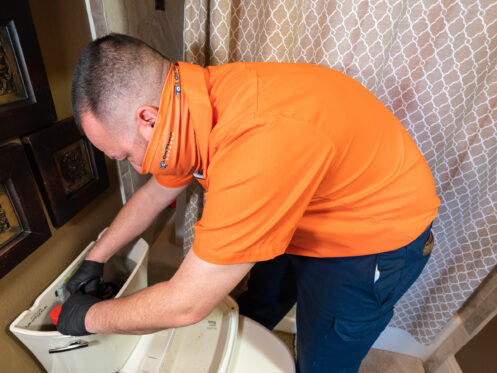Texas heat doesn’t just wear you out; it clings to everything, especially your bathroom. When you add daily showers to already sticky air, mold doesn’t need much to settle in. Poor ventilation, dripping fixtures, and warm, damp corners create ideal conditions for hidden plumbing problems and moisture buildup.
At On Time Experts, we work with homeowners in Garland, Texas, every day to troubleshoot the subtle ways humidity puts stress on bathroom systems. If you’re wiping down mildew frequently, this is your sign to take a closer look. Keeping your basement dry with sump pump service to ensure it’s working properly is an important first step, but here are more tips to prevent mildew and mold.
Moisture Doesn’t Stay in the Shower
Humidity lingers, and your bathroom retains it longer than most rooms. When you take a hot shower, steam fills the air, but without proper ventilation, it has nowhere to go. You might notice a fogged mirror or damp walls, but moisture can also settle in places you can’t see.
It can collect behind baseboards, cling to grout lines, and accumulate near the walls where plumbing runs, especially if there are gaps or weak seals. If your bathroom doesn’t dry out thoroughly each day, mold spores can take hold.
A musty smell, dark corners that won’t stay clean, or condensation that sticks around are all signs of hidden moisture, and often point back to plumbing or ventilation issues.
Slow Drips and Their Hidden Impact
A slow drip might not seem serious, but over time, it can quietly create the perfect environment for mold. A leak at the faucet or the base of the toilet might not leave a visible puddle, but moisture can seep beneath tile or behind drywall and linger for days in a humid climate.
That trapped water won’t evaporate quickly, and it often feeds mold growth behind the scenes. Even if you clean the surface, the underlying problem continues to spread. If your sink feels loose, or you keep finding water under your cabinet, there’s a good chance the plumbing is leaking, and costing more than just on your water bill.
Poor Ventilation Lets Moisture Linger
If your bathroom fan hums but doesn’t pull air efficiently, it could be doing more harm than good. Without proper airflow, steam and warm air from showers remain trapped. That leads to longer dry times for tile, softened paint, and damp grout, all perfect conditions for mold.
Older fans often lose power over time or become clogged with dust. A simple test: hold a tissue near the vent. If it barely moves, your fan isn’t pulling enough air. Bathroom exhaust fans should move at least 1 CFM (cubic feet per minute) per square foot of floor space to be effective.
If your mirror stays foggy long after a shower, it’s a red flag that your fan or ductwork may need repair or replacement.
Under-the-Sink Plumbing Can Trap Condensation
Cabinets under sinks often hide problems that quietly grow. Pipes carrying cold water through warm, humid air sweat due to condensation, leaving dampness behind, even without an actual leak. If your cabinet feels musty, or your toiletries are damp, that moisture could be from pipe sweating or a slow drip.
In tight, enclosed spaces without ventilation, moisture lingers. If the cabinet base is made from particleboard or MDF, it can quickly warp or absorb water. Even small amounts of condensation can lead to mildew buildup over time. If this is a recurring issue, it’s worth inspecting for loose plumbing connections and considering vent additions or moisture-resistant cabinet materials.
Shower Seals and Grout Can Break Down
Daily use of your shower wears down grout and sealant over time. If grout lines aren’t properly sealed or begin to crack, water can penetrate behind the tile. That moisture doesn’t just loosen tiles; it creates a hidden, warm, and damp space where mold thrives.
Once water gets behind the tile, it can soak the wallboard or backer board underneath. If your shower wall has soft spots or the caulk pulls away from the corners, water is likely finding a way in. Resealing grout and inspecting corners where the wall meets the tub or floor can prevent the need for retiling or major shower repairs down the line.
Toilet Leaks Go Unseen
Toilets often leak in quiet ways. A worn-out wax ring or loose flange bolts might not create visible puddles, but water can still seep under the tile and damage the subfloor.
If your toilet rocks when you sit down, or if the flooring around it feels soft, it could indicate water has been leaking for some time. While humidity can expand flooring slightly, consistent movement and leaks from loose seals are the bigger concerns.
Discoloration at the toilet base is another red flag. Replacing the wax ring and resecuring the toilet can stop the problem before mold takes hold beneath your flooring.
Hot Water and Steam Complicate the Mix
Steam from hot water heats up your bathroom walls, mirrors, and floors. That heat draws moisture into materials that might otherwise stay dry, causing paint to soften, wallpaper to peel, and wood or cabinet materials to absorb moisture.
If your hot water pipes run through walls, they may add subtle warmth that increases the likelihood of mold when ventilation is poor. In smaller bathrooms, this issue can be magnified since more surfaces are exposed to heat and steam in a concentrated space. If the air isn’t exchanged fast enough, that trapped humidity settles on everything.
Get Rid of Mold and Prevent It From Coming Back
Mold in your bathroom isn’t just a nuisance; it’s often a sign that your plumbing or ventilation isn’t keeping up with Texas humidity. From fixture repairs to ventilation upgrades and leak detection, small fixes can make a big impact.
At On Time Experts, our plumbing services help Garland homeowners eliminate mold at the source and improve moisture control in high-humidity environments. Whether you need new seals, pipe repairs, or expert advice, we’re here to help.
Schedule a plumbing or moisture inspection with On Time Experts today and take the first step toward a cleaner, drier, and healthier bathroom.

